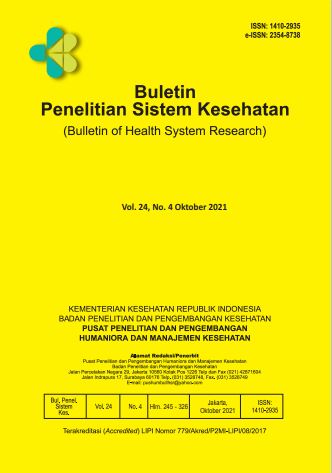Kinerja Pelayanan Kesehatan Ibu dan Anak di Papua Tahun 2018: Apakah input tenaga bidan dan dokter berpengaruh?
Abstract
Maternal and child health is one of factors that indicate the community health status. The study analyzes the relationship between the input of midwives and doctors on the performance of maternal and child health services. This study uses an ecological analysis approach. The population is 42 districts/cities in Papua Island . In addition ,this study analyzes K4, childbirth in health care facilities, and KN1 as the dependent variable. The analysis uses a scatter plot with a linear fit line as a determinant. The study results a very high variation among districts/cities, both the input variable and maternal and child health performance. Spatially, the lowest input of midwives and doctors is more likely to the Central Mountain region. It showed the higher the input of midwives and doctors, the higher the K4 performance. The higher the input of midwives and doctors, the higher the delivery performance at health service facilities. In addition, The higher the input of midwives and doctors is the higher the performance of KN1. The midwife's input has a more significant effect than the doctor's input for all maternal and child health performance. The study concludes that the input range for midwives and doctors in Papua Island is very extensive. The input of midwives and doctors is positively related to the performance of maternal and child health services in Papua Island. K4 is the factor that is least carried out, both by midwives and doctors.
Abstrak
Kesehatan ibu dan anak merupakan salah satu faktor yang mengindikasikan status kesehatan masyarakat di suatu wilayah. Studi ditujukan untuk menganalisis hubungan antara input tenaga bidan dan dokter pada kinerja pelayanan kesehatan ibu dan anak di Pulau Papua. Studi dilakukan dengan pendekatan analisis ekologi. Populasi studi adalah seluruh kabupaten/kota di Pulau Papua (42 kabupaten/kota). Selain input tenaga bidan dan tenaga dokter sebagai variabel independen, studi ini menganalisis K4, persalinan di fasilitas pelayanan kesehatan, dan KN1, sebagai variabel dependen. Analisis memanfaatkan scatter plot dengan garis fit linier sebagai penentu. Hasil studi menunjukkan variasi yang sangat tinggi antar kabupaten/kota, baik pada variabel input tenaga maupun pada kinerja kesehatan ibu dan anak. Secara spasial input tenaga bidan dan dokter yang paling rendah cenderung di wilayah Pegunungan Tengah. Semakin tinggi input tenaga bidan maupun tenaga dokter, semakin tinggi pula kinerja K4 di kabupaten/kota tersebut. Semakin tinggi input tenaga bidan maupun tenaga dokter, maka semakin tinggi pula kinerja persalinan di fasilitas pelayanan kesehatan di wilayah tersebut. Semakin tinggi input tenaga bidan maupun tenaga dokter, maka semakin tinggi pula kinerja KN1 di area tersebut. Lebih lanjut, input tenaga bidan memiliki efek yang lebih bermakna dibanding input tenaga dokter untuk seluruh kinerja kesehatan ibu dan anak. Studi menyimpulkan bahwa rentang input tenaga bidan dan dokter di Pulau Papua sangat lebar. Input tenaga bidan dan tenaga dokter berhubungan secara positif dengan kinerja pelayanan kesehatan ibu dan anak di Pulau Papua. K4 merupakan faktor yang paling kurang dilakukan, baik oleh tenaga bidan maupun tenaga dokter.
References
Anindya, K. et al. (2020) ‘Impact of Indonesia’s national health insurance scheme on inequality in access to maternal health services: A propensity score matched analysis’, Journal of Global Health, 10(1), pp. 1–12. https://doi.org/10.7189/JOGH.10.010429.
Ariwinanti, D. et al. (2020) ‘The Muyu Women and Their Birthing Culture: How to Move Labor to Health Facilities’, in The 3rd International Conference on Sports Sciences and Health 2019 (ICSSH 2019). Denpasar: Atlantis Press, pp. 14–18. https://doi.org/10.2991/ahsr.k.201107.004.
Basha, G. W. (2019) ‘Factors Affecting the Utilization of a Minimum of Four Antenatal Care Services in Ethiopia’, Obstetrics and Gynecology International, 2019. https://doi.org/10.1155/2019/5036783.
Budiratna, H. and Qibthiyyah, R. M. (2020) ‘Evaluasi Atas Transfer Dana Otonomi Khusus Di Aceh, Papua, Dan Papua Barat’, Jurnal Indonesia Sosial Sains, 1(5), pp. 402–414. https://doi.org/10.36418/jiss.v1i5.103.
Chanda, S. K. et al. (2020) ‘Factors associating different antenatal care contacts of women: A cross-sectional analysis of Bangladesh demographic and health survey 2014 data’, PLoS ONE, 15(4), pp. 1–17. https://doi.org/10.1371/journal.pone.0232257.
Crear-Perry, J. et al. (2021) ‘Social and Structural Determinants of Health Inequities in Maternal Health’, Journal of Women’s Health, 30(2), pp. 230–235. https://doi.org/10.1089/jwh.2020.8882.
Dickson, K. S., Darteh, E. K. M. and Kumi-Kyereme, A. (2017) ‘Providers of antenatal care services in Ghana: Evidence from Ghana demographic and health surveys 1988-2014’, BMC Health Services Research. BMC Health Services Research, 17(1), pp. 1–9. https://doi.org/10.1186/s12913-017-2145-z.
Dinas Kesehatan Provinsi Papua (2006) Survei Kesehatan Daerah Papua Tahun 2006. Jayapura.
Doctor, H. V., Nkhana-Salimu, S. and Abdulsalam-Anibilowo, M. (2018) ‘Health facility delivery in sub-Saharan Africa: Successes, challenges, and implications for the 2030 development agenda’, BMC Public Health. BMC Public Health, 18(1), pp. 1–13. https://doi.org/10.1186/s12889-018-5695-z.
Giyai, A. (2015) Melawan Badai Kepunahan Gebrakan Papua Sehat Menuju Papua Bangkit Mandiri dan Sejahtera. Jayapura: Papua Pusaka Raya. Available at: http://perpustakaan.bppsdmk.kemkes.go.id//index.php?p=show_detail&id=4881.
Herfina Y Nababan, Md Hasan, Tiara Marthias, Rolina Dhital, Aminur Rahman, I. A. (2018) ‘Trends and inequities in use of maternal health care services in Indonesia , 1986 – 2012’, International Journal of Women’s Health, 10, pp. 11–24.
Kabira, M. R. et al. (2020) ‘Factors associated with antenatal and health facility delivery care in selected areas of Subornochor upazila, Noakhali, Bangladesh’, Clinical Epidemiology and Global Health, 8(3), pp. 983–988.
Karanja, S. et al. (2018) ‘Factors influencing deliveries at health facilities in a rural Maasai Community in Magadi sub-County, Kenya’, BMC Pregnancy and Childbirth. BMC Pregnancy and Childbirth, 18(1), pp. 1–11. https://doi.org/10.1186/s12884-017-1632-x.
Kementerian Kesehatan RI (2018) Indeks Pembangunan Kesehatan Masyarakat 1. Edited by D. A. M. Trihono, Agus Suwandono, Atmarita. Jakarta: Lembaga Penerbit Balitbangkes.
Kurniawan, A. et al. (2012) The 2012 Ethnographic Series of Maternal and Child Health Books, Ngalum Ethnic, Oksibil District, Pegunungan Bintang Regency, Papua Province (Buku Seri Etnografi Kesehatan Ibu dan Anak 2012 Etnik Ngalum, Distrik Oksibil Kabupaten Pegunungan Bintang, Provi. Surabaya: Pusat Humaniora, Kebijakan Kesehatan dan Pemberdayaan Masyarakat. Available at: https://www.scribd.com/doc/142715053/Buku-Seri-Etnografi-Kesehatan-Ibu-dan-Anak-2012-Etnik-Ngalum-Distrik-Oksibil-Kabupaten-Pegunungan-Bintang-Provinsi-Papua.
Kurniawan, A. and Laksono, A. D. (2013) ‘Innovation in Tradition: Efforts to Improve the Degree of Women’s Health in Ngalum (Inovasi Dalam Balutan Tradisi: Upaya Meningkatkan Derajat Kesehatan Perempuan Ngalum)’, in Angkasawati, T. J., Handayani, L., and Laksono, A. D. (eds). Jogjakarta: Kanisius, pp. 129–143.
Laksono, A. D. et al. (2016) Healthcare Accessibility in Indonesia (Aksesibilitas Pelayanan Kesehatan di Indonesia). Edited by S. Supriyanto, D. Chalidyanto, and R. D. Wulandari. PT Kanisius.
Laksono, A. D. et al. (2020) ‘The Concept of Illness among Ethnic Groups in Indonesia: A Meta-Ethnographic Study’, Systematic Reviews in Pharmacy, 11(9), pp. 584–591. https://doi.org/10.31838/srp.2020.9.85.
Laksono, A. D., Dewi, Y. S. and Wulandari, R. D. (2020) ‘Muyu tribes’ local wisdom: complimentary care for limited health access’, Eurasian Journal of Biosciences, 14(2), pp. 5871–5878.
Laksono, A. D., Ridlo, I. A. and Ernawaty (2019) ‘Distribution Analysis of Doctors in Indonesia’, p. 2019. https://doi.org/10.31227/osf.io/df6ns.
Laksono, A. D. and Wulandari, R. D. (2019) ‘“Children are Assets”: Meta Synthesis of Child Values in the Lani and Acehnese (“Anak adalah Aset”: Meta Sintesis Nilai Anak pada Suku Lani dan Suku Aceh)’, Jurnal Kesehatan Reproduksi, 10(1), pp. 11–20. https://doi.org/10.22435/kespro.v10i1.933.11-20.
Laksono, A. D. and Wulandari, R. D. (2020) ‘Predictors of Hospital Utilization Among Papuans in Indonesia’, Indian Journal of Forensic Medicine and Toxicology, 14(2), pp. 2319–2324.
Laksono, A. D. and Wulandari, R. D. (2021) ‘The Border-Non-Border Areas Disparities in Hospital Utilization in Kalimantan Island, Indonesia’, Medico-Legal Update, 21(1), pp. 29–34. https://doi.org/10.37506/mlu.v21i1.2274.
Masruroh et al. (2021) ‘Neonatal Death Incidence in Healthcare Facility in Indonesia: Does Antenatal Care Matter?’, Indian Journal of Forensic Medicine and Toxicology, 15(1), pp. 1265–1271. https://doi.org/10.37506/ijfmt.v15i1.13590.
Nasution, S. K., Mahendradhata, Y. and Trisnantoro, L. (2020) ‘Can a National Health Insurance Policy Increase Equity in the Utilization of Skilled Birth Attendants in Indonesia? A Secondary Analysis of the 2012 to 2016 National Socio-Economic Survey of Indonesia’, Asia-Pacific Journal of Public Health, 32(1), pp. 19–26. https://doi.org/10.1177/1010539519892394.
Nurlinawati, I. and Putranto, R. H. (2020) ‘Faktor-Faktor Terkait Penempatan Tenaga Kesehatan di Fasilitas Pelayanan Kesehatan Tingkat Pertama Daerah Terpencil/Sangat Terpencil’, Jurnal Penelitian dan Pengembangan Pelayanan Kesehatan, 4(1), pp. 31–38. https://doi.org/10.22435/jpppk.v4i1.3312.
Nurrizka, R. H. and Wahyono, T. Y. M. (2018) ‘Disparity of Maternal Mortality in Indonesia: Ecological Study with Spatial Analysis’, Jurnal MKMI, 14(2), pp. 119–127. https://doi.org/10.30597/mkmi.v14i2.3630.
Olorunsaiye, C. Z. et al. (2020) ‘Factors associated with health facility delivery in West and Central Africa: A multilevel analysis of seven countries’, Health Care for Women International, 41(1), pp. 3–21.
Pratiwi, N. L. et al. (2014) ‘Policy Review on the Distribution of Health Operational Assistance Funds in Support of Achieving Maternal and Child Health (MDG’s 4,5) in Three Districts, Cities in East Java Province’, Buletin Penelitian Sistem Kesehatan, 17(4), pp. 395–405.
Ridwanah, A. A., Megatsari, H. and Laksono, A. D. (2020) ‘Hypertension in Indonesia in 2018 : An Ecological Analysis’, (December). https://doi.org/10.13140/RG.2.2.26827.00803.
Rohmah, N. et al. (2020) ‘Determinants of teenage pregnancy in Indonesia’, Indian Journal of Forensic Medicine and Toxicology, 14(3), pp. 2080–2085 https://doi.org/10.37506/ijfmt.v14i3.10736.
Sarker, B. K. et al. (2020) ‘Status of the WHO recommended timing and frequency of antenatal care visits in Northern Bangladesh’, PLoS ONE, 15(11), pp. 1–21. https://doi.org/10.1371/journal.pone.0241185.
Setianingsih, T. (2020a) ‘Analysis of Individual Factors on Mother’s Behavior in the First Neonatal Visit (KN1) in 8 Provinces in Indonesia’, in International Conference of Health Development. Covid-19 and the Role of Healthcare Workers in the Industrial Era (ICHD 2020), pp. 310–314. https://doi.org/10.2991/ahsr.k.201125.054.
Setianingsih, T. (2020b) ‘Performance Analysis Of Children ’ S Health Program In Indonesia : A Multilevel Analysis.’, in The 7th International Conference on Public Health The 7th. International Conference on Public Health Solo , Indonesia , November 18-19 , 2020 |140, pp. 139–145.
Siswanto (2020) Situasi kesehatan indonesia 2015-2019. Jakarta.
Situmorang, H. E. (2020) ‘Nurse’s Perception Of Factors Related To Neonatal Health Services In Papua’, Jurnal Keperawatan Tropis Papua, 3(1), pp. 120–126. https://doi.org/10.47539/jktp.v3i1.96.
Soewondo, P. et al. (2019) ‘Inspecting Primary Healthcare Centers in Remote Areas: Facilities, Activities, and Finances’, Jurnal Administrasi Kesehatan Indonesia, 7(1), pp. 89–98. https://doi.org/10.20473/jaki.v7i1.2019.89-98.
Suharmiati, Laksono, A. D. and Astuti, W. D. (2013) ‘Policy Review on Health Services in Primary Health Center in the Border and Remote Area (Review Kebijakan tentang Pelayanan Kesehatan Puskesmas di Daerah Terpencil Perbatasan)’, Bulletin of Health System Research, 16(2), pp. 109–116.
Sukirman, R., Wahyono, T. Y. M. and Shivalli, S. (2020) ‘Determinants of healthcare facility utilization for childbirth in Kuantan Singingi regency, Riau province, Indonesia 2017’, BMC Public Health. BMC Public Health, 20(1), pp. 1–10. https://doi.org/10.1186/s12889-020-09035-3.
Sutrisna, A. (2017) ‘Desk Review of Maternal , Neonatal and Child Health in Indonesia’.
Utami, S. M. et al. (2020) ‘Ecological Analysis of Preeclampsia/Eclampsia Case in Sidoarjo Regency, Indonesia, 2015-2019’, Indian Journal of Forensic Medicine and Toxicology, 14(4), pp. 3474–3479. https://doi.org/10.37506/ijfmt.v14i4.12164.
Utomo, B. et al. (2021) ‘The impact of family planning on maternal mortality in Indonesia: what future contribution can be expected?’, Population Health Metrics. Population Health Metrics, 19(1), pp. 1–13. https://doi.org/10.1186/s12963-020-00245-w.
Wardoyo, A. R. et al. (2020) ‘The Concept of Health and Illness and the Treatment-seeking Behavior from the Cultural Perspective of Assotipo Tribes in Assotipo District, Jayawijaya Regency, Papua Province’, International Journal of Sciences: Basic and Applied Research, 54(2), pp. 1–11.
Wulandari, R. D. et al. (2021) ‘Barriers to Antenatal Care Utilization in Indonesia’, Medico-Legal Update, 21(1), pp. 828–834. https://doi.org/10.37506/mlu.v21i1.2419.
Wulandari, R. D. and Laksono, A. D. (2019) ‘Hubungan Antara Rasio Bidan Dengan Kinerja Program Kesehatan Ibu Dan Anak Di Indonesia’, Buletin Penelitian Sistem Kesehatan, 22(3). https://doi.org/10.22435/hsr.v22i3.1740.
Wulandari, R. D. and Laksono, A. D. (2020) ‘Is parity a predictor of neonatal death in Indonesia? Analysis of the 2017 Indonesia demographic and health survey’, Indian Journal of Forensic Medicine and Toxicology, 14(3), pp. 2161–2166.
Wulandari, R. D., Putri, N. K. and Laksono, A. D. (2020) ‘Socioeconomic Disparities in Antenatal Care Utilisation in Urban Indonesia’, International Journal of Innovation, Creativity and Change, 14(2), pp. 498–514.
Yaya, S. et al. (2018) ‘Why some women fail to give birth at health facilities: A comparative study between Ethiopia and Nigeria’, PLoS ONE, 13(5), pp. 1–11. https://doi.org/10.1371/journal.pone.0196896.
Yesica, D. et al. (2021) ‘Ecological Analysis of Maternity Care in Indonesia in 2018’, Indian Journal of Forensic Medicine and Toxicology, 15(2), pp. 2261–2267. https://doi.org/10.37506/ijfmt.v15i2.14708.


















